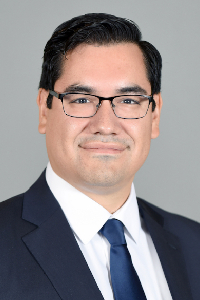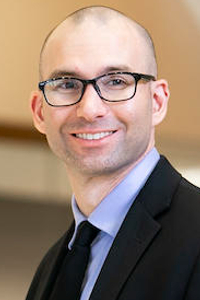By Zaena Ballon
As part of the ongoing “Spotlight on Sections” series, AALS sat down with the leadership of the Section on Indian Nations and Indigenous Peoples for a Q&A. The Section promotes the communication of ideas, interests, and activities among members of the Section and others in related fields and makes recommendations on matters of interest in the teaching and improvement of the law relating to Indian nations and Indigenous peoples.
Chair: Trevor Reed, Arizona State University Sandra Day O’Connor College of Law
Chair-Elect: Adam Crepelle, Antonin Scalia Law School at George Mason University


Trevor Reed: I think our section has always been very inclusive and welcoming, and interested in giving our members leadership experience and opportunities to develop professionally. In my first year on the tenure track, my colleagues at ASU invited me to attend our section’s session at the AALS Annual Meeting for the first time. It was an excellent panel with now Secretary of the Interior Deb Haaland and Representative Sharice Davids. Not long after the panel ended, the section leaders called for nominations and suddenly I was part of the section leadership. I’m actually grateful for that. Being on the executive board gave me the opportunity to get to know people in Indigenous law around the country and be included in conversations happening in our field.
Adam Crepelle: My experience was quite similar to Trevor’s. I remember showing up at the section program. Trevor and I were among the first few people there. I guess being junior professors we tend to show up early. As Trevor said, the panel was great, and I was nominated to serve in section leadership.
TR: Our leadership structure is similar to many AALS sections with four officers: a chair, chair-elect, secretary, and treasurer. We also have an executive committee made up of the three prior chairs. But one thing that is unique about our section is that we do a lot of our decision-making by consensus. This may be a nod to our traditional values, or the general tone of Indigenous law as a field. But whatever the case, I think everyone on our board has a commitment to working together for the benefit of Indigenous peoples.
I also want to point out that we have had several non-Indigenous individuals in leadership roles, and really anyone can be a part of our section. Federal Indian law, tribal law, and Indigenous law in general, is an all-encompassing body of law. It touches on every legal subject.
AC: The section’s members work in many capacities because Indian law covers virtually every area of the law. Our members are writing about property law, water law, criminal law, economic development, intellectual property as well as other topics. Many of them are tribal court judges as well. It’s tough to narrow down what the section’s member do. The better question may be what don’t they do?
TR: We highlight scholarly work in our newsletter and maintain a pretty robust communication list. Members can share or ask for teaching tips or present ideas on case decisions and people jump on and have comments. We also usually host or co-sponsor quite a few panels during AALS meetings. We have held section webinars and social events. Last year, our Section, under the leadership of Angelique EagleWoman, hosted an international social event where we invited Canadian scholars to join with us and work across the border. Members of our section have also been involved in organizing what we have been calling a gathering of Indigenous law scholars or GILS. This is a chance for people going on the teaching market to get feedback on papers and presentation style and start to network with Indian law professors. ASU and UCLA hosted the gathering in December of 2021 in Phoenix. We’ll likely do others in the coming years. The goal is to create an inclusive space with law faculty welcoming new scholars in the same way that Adam and I were welcomed into the section.
TR: One big issue that many of us have been working to address is how to help faculty in all subjects incorporate tribal and federal Indian law topics into their core courses like Constitutional Law, Property, Criminal Law, Evidence, and others. Indigenous law is deeply embedded in all of these areas, but it is often overlooked. Put another way, how do we decolonize the law school curriculum to help undo centuries of erasure of Indigenous peoples, and find meaningful ways to have Indigenous presences in what we teach.
One of our section members, Dylan Hedden-Nicely (University of Idaho’s College of Law), has proactively created a Sovereignty Series of webinars to address this very issue. He invited other section members and subject matter experts to talk about how they infuse their syllabuses with Indian law issues.
AC: In addition to the law school curriculum, we’re often talking to other areas of the campus. One of the big issues we face as Indian law practitioners is that hardly anyone knows anything about tribal sovereignty. Most people tend to think they’re just racial groups or something rather than sovereigns. At George Mason, I’m working closely with some of my economics colleagues to try to integrate federal Indian law into what they’re doing.
TR: There are also significant disparities in the way that Indigenous students are performing in law schools, from admission rates, LSAT performance, to success on the bar exam, the number of Indigenous people in law firms and on the bench. I believe it falls to us as law faculty to address those challenges and hopefully have equal representation from Indigenous students and Indigenous professionals in our field.
TR: We have a national Native American Law Students Association with individual chapters in many law schools. It was amazing to hear their experiences and interact with them, to listen to what they’re going through and how they’re navigating law school. We can start to think about what actions we need to take. How can we collaborate and make sure that our Indigenous students are cared for? How can we advocate for them? I want to specifically acknowledge Angelique EagleWoman, who’s been spearheading a lot of these efforts in our Section. I also want to recognize the important work that the Pre-Law Summer Institute (PLSI) does for incoming first-year Indigenous law students, and the impact the Pathway to Law initiative that many schools have joined has had on student success.
Many of our Section members also attend a large professional convening, usually in April, of the Federal Bar Association’s Indian law section. Additionally, several schools have specialized Indian law programs, and those schools have webinars that a lot of our members attend and participate in. Finally, the gathering of Indigenous law scholars is beginning to happen again, and we look forward to seeing more and more of these kinds of activities for emerging law scholars.
The Section also develops resolutions in support of specific issues. When Secretary of the Interior Debra Haaland was up for nomination, our Section rallied around to support her successful nomination. The section gives us the opportunity to create that community of support.
TR: We have four panels. Our first is “Indigenizing Intellectual Property.” There are a host of conversations happening around intellectual property, cultural property, and Indigenous identity, from disparaging mascots to cultural heritage protections. This panel is going to focus on how law schools and scholars can engage issues around Indigenous identities, culture, and creativity.
We also have a panel called “Indigenous Law Professors as Relatives Across the Medicine Line.” Many American law schools have not yet heard about Canada’s new mandate that every law school student take a course on Indigenous Peoples and the Law. We’d love to see this happen in the United States. The panel is a pedagogy session; we’re going to be learning from our relatives across the international border about how they’re teaching these issues in the mainstream classroom.
We’re also going to have a panel called “Pedagogical Lessons from the Indian Child Welfare Act.” There was a critically important Supreme Court case this argued this term, Haaland v. Brackeen. It will decide the future of the Indian Child Welfare Act, which provides states and private parties with a framework for child custody matters invovling Indigenous children. Our panel will discuss how to teach that law in family law courses and other areas of the curriculum.
Finally, we have a panel called “From Aspiration to Implementation for Energy and Environmental Justice,” which will address how governments can carry out environmental justice policies, including the use of tribal co-management strategies on federal lands, especially as the government is moving towards clean energy.
AC: In 2023, I’ll be taking the helm following Trevor’s tremendous year in office. The section will be dealing with the aftermath of the Brackeen decision. We don’t know how that’s going to shake out yet, but Brackeen is certainly going to be a major topic. Next year is the 200-year anniversary of Johnson v. M’Intosh, one of the foundational cases in federal Indian law and property law in general. We’ll be hosting webinars examining Johnson and its continuing implications. One of the areas I’m interested in personally is tribal economic development. As the section chair, I’ll try to infuse that topic into the section.
TR: I would say the same as getting involved in any AALS section: join the section, be involved, join our discussion list, and be involved in the conversations. For new or experienced faculty, come serve on the executive board. We would love to have more people take part.
AC: Our section is not limited to those who focus only on federal Indian law. If you teach any subject, there are ways to integrate Indian law into your teaching. If you’re just interested in trying to infuse Indian law into what you’re doing, we’d welcome you to join the section.
TR: I would also encourage faculty to get to know the tribes that are in their area. We all live on and work on Indigenous lands, and it’s important that we take initiative to find out who those Indigenous peoples are, understand their legal systems, and hopefully incorporate Indigenous laws and policies and ways of doing governance into the way that we teach and work.